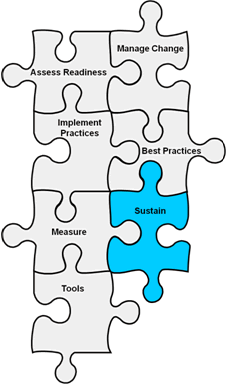
Those who have been involved in multiple organizational change projects recognize that the only step more difficult than implementing the initial changes is ensuring that those changes become woven into the day-to-day fabric of operations so that they are sustained beyond the life of the formal improvement effort or special campaign. It is sometimes easy to adopt new practices in response to an immediate need, such as an impending Joint Commission visit, and considerably more difficult to maintain those practices over time. To achieve this goal, it is essential that the changes become integrated into existing organizational structures and routines and that management's goals and reporting mechanisms are in alignment with the new standards and practices. While sustaining changes logically follows initial improvements, it is important to begin thinking early in the improvement process about what will be needed to make lasting change. Throughout the implementation process, you should consider questions such as:
- Who will be responsible for sustaining active pressure ulcer prevention efforts on an ongoing basis?
- What types of ongoing organizational support do we need from others to keep the new practices in place?
- How can we reinforce the desired results?
6.1 Who will be responsible for sustaining active pressure ulcer prevention efforts on an ongoing basis?
The role of the Implementation Team will change as new practices are successfully adopted. A key decision for your organization will be whether to keep the Implementation Team going or to transfer the responsibility for sustaining active pressure ulcer prevention to another group. The decision will be influenced by your organizational structure, improvement culture, and location of commitment to pressure ulcer prevention. For example, if the Implementation Team has been chartered as an ad hoc, time-limited quality improvement team and the expectation in your organization is that it will be disbanded, you may need to hand off responsibility to an ongoing committee or operational owner. Or if on a sustained basis, the work of the Implementation Team will duplicate or compete with an ongoing committee that is active and capable, then you may want to transfer responsibility. On the other hand, if there is no other team—for example, the Skin Committee has too many responsibilities or is not an engaged group—you will need to keep the Implementation Team active, although you may decide to reduce the frequency of team meetings.
If the Implementation Team decides to hand off responsibility, it must identify which hospital manager or team will "own" oversight responsibility for pressure ulcer prevention practices on an ongoing basis. The Implementation Team will need to hand off all information about the project and ongoing reporting efforts before making the decision to reduce or stop meetings.
The critical point is that ongoing responsibility for pressure ulcer prevention should be clearly assigned. For ease of presentation in the rest of this section, we will refer to the group responsible for pressure ulcer prevention going forward as the Sustainability Team, whether it is the original Implementation Team or a different group. The Sustainability Team will serve as a key dissemination point for new information (e.g., team education sessions with invited speakers) and take up new challenges (e.g., revise online documentation forms).
The Sustainability Team will continue to ensure that collection of data and regular reporting of rates are taking place and that these activities become fully integrated into regular work processes. Intermittent meetings will be important in discussing outcomes and updating materials and policies on an ongoing basis as more information about the project's effect becomes available.
6.2 What types of ongoing organizational support do we need to keep the new practices in place?
While the frontline work to prevent pressure ulcers depends on unit staff and the Wound Care Team, the Sustainability Team will need support from other parts of the organization to be successful on an ongoing basis. Support will take the form, for example, of training for new employees and refresher training for current employees; human resources promptly filling staff vacancies; facility management for supplies and equipment; and information technology staff support to assist with regularly reporting monitoring data.
If your organization is using Unit Champions, the Sustainability Team will need to consider strategies for keeping them engaged and a method to replace Unit Champions when the original champions change responsibilities or positions. Similarly, if you do not have Unit Champions but multiple staff who serve as pressure ulcer resource staff on the units, you will need processes for keeping them engaged and replacing them when needed.
The Sustainability Team also will need to consider how to engage and communicate with the staff at large about the new practices as they become integrated into ongoing operations. This communication is essential for keeping staff involved and up to date. Consider ongoing information briefs in your staff bulletin. Posters can also be used; rotating them every few weeks may be important in keeping staff engaged and involved. Some teams have even posted "on the john" or "potty briefs" flyers in staff bathrooms detailing a skin issue on a monthly basis. Be sure that pressure ulcer prevention becomes a standard part of yearly staff education fairs or other similar events.
To further solidify ongoing support, you should determine to which oversight committee pressure ulcer prevention will report in the larger organizational structure. The most appropriate committee will depend on the structure of your organization. In some places it may be the Patient Safety Committee, in others the Quality Council. It is important that the group report to hospital leadership so that pressure ulcer prevention will have the leadership attention needed for continued accountability and to ensure support of other divisions as needed.
In addition to assessing the extent to which processes and outcomes of care appear to be changing in response to the pressure ulcer prevention program, it is important to examine the extent to which organizational structures and routines have also changed. Without such change, it is possible that only short-term gains will be accomplished. Examples of items that might be assessed are described below.

Action Steps
Examples of assessment items for structures and routines that support pressure ulcer prevention:
- Are unit staff very familiar with their role in preventing pressure ulcers and how their role relates to other staff members involved in pressure ulcer prevention?
- Are there unit experts of some sort who can be given extra training and work within units to maintain skin care awareness and knowledge?
- Can you identify systems or prompts that have been put into place to ensure that care is carried out appropriately? For example, does the electronic medical record now have a section on skin care assessment and treatment?
- Have barriers to obtaining needed supplies and equipment, such as support surfaces, been addressed?
- Is performance being routinely tracked?
- Are performance data regularly reported to the staff?
- It there a committee reporting to hospital leadership that monitors pressure ulcer data, holds staff accountable, and ensures that needed resources are available to keep rates low?
6.3 How can we reinforce the desired results?
Generating and maintaining excitement about change is critical to success. Given the difficulty in improving care, improvements in performance measures may not initially be evident. It is thus important to find small successes early on which can be rewarded (e.g., the calculation of incidence and prevalence rates depends on completion of the monthly skin documentation form). Consider giving a small framed certificate or other acknowledgement to unit staff the first time the skin documentation form is completed correctly. The key is to find small and regular ways to recognize when unit staff members do the right thing.
- Reward changed behavior at the unit level: For example, you might start by giving certificates to the units turning in reports on time and slowly raise the bar to awards for 100 percent documentation of skin and risk assessment within 8 hours or no facility-acquired pressure ulcers in a 3-month period (or whatever outcomes your organization has selected). Consider giving rewards to the unit with the greatest decrease in pressure ulcer incidence. Post results and comparative information for units and for the facility in general.
- Reward changed behavior at the individual level: For example, you might ask Unit Champions to nominate a staff member (from a variety of disciplines) quarterly to receive recognition as an individual who made a difference in pressure ulcer prevention. Also, consider taking steps to encourage and reward staff members seeking additional education on pressure ulcer prevention.

Additional Information
Gibbons W. Shanks HT. Kleinhelter P. Jones P. Eliminating Facility-Acquired Pressure Ulcers at Ascension Health. Journal on Quality and Patient Safety 2006:32(9): 488-496.
This article describes strategies to reinforce desired outcomes. Key points from this article include:
- The importance of continued leadership support and staff dedication at all levels.
- Rewarding staff with pizza parties and gift certificates to help them stay motivated.
- Ongoing monitoring and measuring of pressure ulcer rates.
6.4 Summary and plan for moving forward
Significant time and effort have gone into getting your hospital to this point. By now, you have been successful at changing how things get done and in implementing best practices for pressure ulcer prevention. These best practices have become the standard way care is now provided. Because of these changes, you can now demonstrate how your patients have better outcomes with fewer pressure ulcers developing. These are major achievements for the Implementation Team and the hospital, and everyone should be congratulated for this collective effort.
At this point, you have reorganized your Implementation Team to be a Sustainability Team. Ongoing vigilance will still be required in a number of areas:
- Turnover will mean that new staff will come onto units who do not have the same knowledge as existing staff who have been exposed to your education and awareness activities. Ensure that orientation for new clinical staff is modified to include a focus on skin care.
- Old habits have a way of resurfacing. Despite all the changes, people may slowly go back to the approach they are more used to. This tendency supports the need for ongoing refresher training in the context of the needs of each particular unit.
- Additional quality improvement efforts may be initiated in areas other than pressure ulcers. The changes in practice that are implemented may affect pressure ulcer care in unexpected ways. For example, at one facility, a new focus on reducing indwelling urinary catheter time led to an increase in skin moisture and related skin changes.
- Practices that had become accepted may suddenly be more difficult to perform or the availability of needed resources may change. Such unintended consequences of quality improvement are well recognized. For example, a new cost management system of charging specialty bed costs back to unit budgets may create a disincentive for unit managers to order such beds even when indicated for preventive purposes.
- New problems may arise due to unannounced changes in other policies and/or products. For example, one hospital noticed an increase in tubing-related pressure ulcers. Investigation revealed that the tubing vendor had made an unannounced change to more rigid tubing that posed a greater danger of pressure-related skin damage.
- Best practices in pressure ulcer care also continue to evolve. New studies are performed that may require you to reconsider your practices. As your content experts, the Wound Care Team can update the entire hospital on such changes in recommended practices.
Finally, always remember that no matter how well you are doing, sustained attention is still needed to keep improvements on track. Perfection in pressure ulcer prevention care is never achieved. There are always additional steps to get closer to the ideal of zero incidence of avoidable pressure ulcers.



